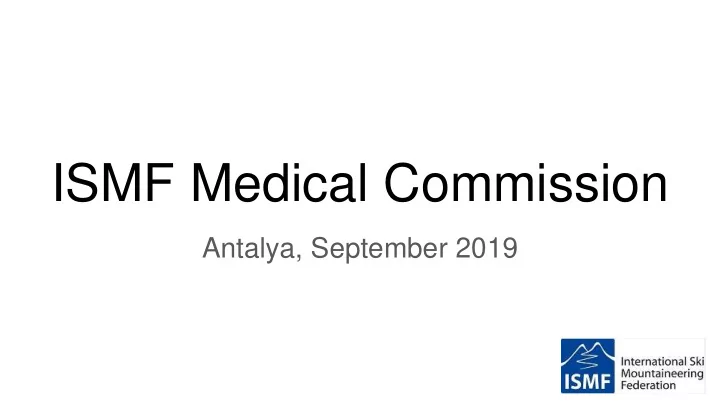

ISMF Medical Commission Antalya, September 2019
Who is on the Medical Commission? -Scrimgeour Carron, (UK) -Xavier Sant Vilella (Spain) - Miroslav Hudec (Slovakia) -Giovanni Montani (Italy) - Andrea Sciolla (Italy) -Bernat Escoda Alegret (Andorra)
What has the Medical Commission been working on? ‘Medical Certificates’ for athletes and for referees. Rules for racing in Cold/Extreme weather conditions Rules for racing at altitude WADA Youth and Ski-Mountaineering ‘Ski - Mountaineering Injury’ surveillance system
Rules: Racing in the cold and extreme weather Danger for racers, but also referees exists if it is very cold. Any injury become much worse when the patient gets cold: hypothermia KILLS Frostbite can cause life long disability It is our responsibility to ensure that racers are safe on any part of the race even if they have an accident. Evacuation of an injured skier can take a long time, during which hypothermia will worsen.
Rules: Racing in the cold and extreme weather “Windchill factor” takes into account the wind and air temperature and gives a much better reading on what the conditions feel like than if you look at only aire temperature. It can be measured with a simple device:
From ISMF website Proposal for rules: (to be used as recommendations only for season 2018-2019) To be applied to all ISMF races (Individual, Sprint, Vertical, Relay) Measurement of temperatures and wind speed Who? The race technical director ensures that an accurate temperature and wind speed is taken by a race official with certified measuring equipment What? Wind speed= fastest speed recorded over a minute, in an exposed place of the transition are, recorded in km/hour. The measurement are to be rounded up ( ie -13° becomes -10° when reading on the chart) Actual Air temperature: temperature in °C recorded out of the wind and the sun. Rounded up. Wind Chill Temperature: this is the adjusted temperature as relayed by the chart.
Rules for cold When? This is to be obtained 20 minutes before the official start of the race. If the race start is delayed, then the temperatures and wind speed must be re-assessed 20 minutes before the next provisional start time. Where? The measurements are done on the start area , the finish area and the high point of the race. The high point is defined as the transition area at the highest altitude on the course. The race director must then cross- reference the air temperature and wind speed on the ‘wind chill’ chart. He thus obtains the Wind chill temperature of the three points: start, high point, finish.
RULES ● If the Wind Chill Temperature is in the minus 10 °C to minus 25 °C range (the moderate risk, Orange on the chart) at any point on the course, recommendations regarding cold weather protection should be made available to the participants. Under such conditions it is the responsibility of the participants to seek the information and to follow the recommendations given by the organiser. ● If the Wind Chill Temperature is colder than minus 25 °C at any of the three measurement points, the race must not start. ○ the competition can be delayed (if it is reasonably expected that temperature will rise during the course of the day) and further measurements done every 30 minutes. ○ The competition must be cancelled if the weather forecast does not expect the temperatures to rise significantly or the wind to die down.
Wind chill chart:
Racing at altitude: DANGER! Altitude Sickness: can come in many forms, from a headache and fatigue, all the way to lethal pulmonary oedema and cerebral oedema. It can happen to anybody, regardless of how ‘fit’ or how old they are: skimo racers are no exception. If a race is organised at altitude, the entire race staff is also at risk of developing sickness: team coaches, physios, doctors, as well as ISMF referees, those looking after safety etc… The only proper prevention is acclimatization, which can take days or weeks.
Racing at altitude: DANGER! The medical commission (in coordination with EXALT) feels that to minimise the risk linked to altitude: ● Racers should not spend more than 4 hours above 3500; ● No more than 2 hours above 4000m; ● No racing higher than 4500m. Special information/warning must be sent out to coaches/athletes/ ISMF officials if the residence/sleeping area is > 2500m in order to prevent altitude-related illness.
Future projects: Lausanne 2020: doctor on site for the race days. Partnership with CISA-IKAR. Standardising race safety and evacuation routes for injured skiers. Skimo Injury Surveillance system- audit on ISMF licenced racers’ injuries. By learning what injuries happen during training and racing, we might be able to install useful prevention measures. Special medical certificate for racing at altitude? Need for specific equipment (Portable chambers)
Recommend
More recommend